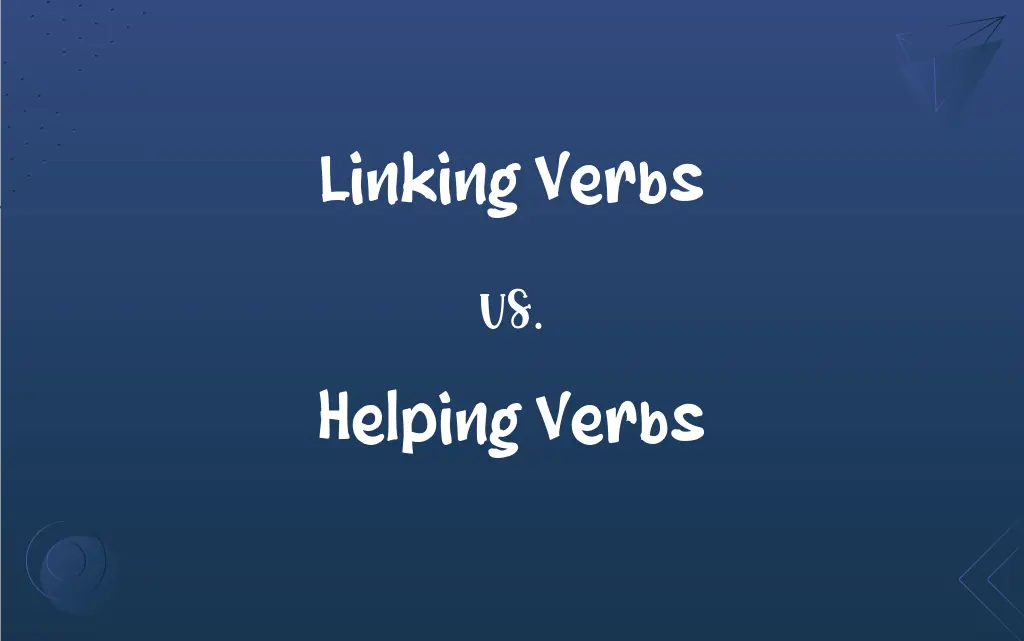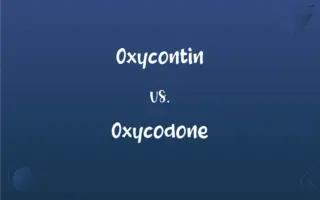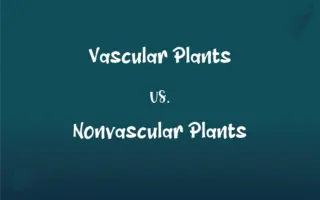Linking Verbs vs. Helping Verbs: What's the Difference?
Edited by Aimie Carlson || By Harlon Moss || Updated on October 6, 2023
Linking verbs connect the subject to a subject complement, while helping verbs assist the main verb to express tense, mood, or voice.

Key Differences
Linking verbs serve as a bridge between the subject of a sentence and its complement, often an adjective or noun. Common linking verbs include "be," "seem," "become," and "appear." For instance, in the sentence "She is a teacher," "is" connects "She" to "teacher." On the other hand, helping verbs, also known as auxiliary verbs, aid the main verb in a sentence to convey additional nuances related to tense, mood, or voice.
Linking verbs don't typically express action. Their primary role is to link or connect the subject to a state of being or condition. Consider the sentence "The sky looks blue." Here, "looks" doesn't indicate any action but establishes a link between "sky" and "blue." Contrastingly, helping verbs are partnered with main verbs to establish details such as the timing of the action. For example, in "She has written a book," "has" assists the main verb "written" to indicate a completed action in the past.
While it's possible for a verb to function as both a linking verb and a helping verb depending on the context, their roles in a sentence are distinct. For example, "be" can be a linking verb in "They are happy," but it can also be a helping verb in "They are running." In the latter, "are" helps specify the present continuous tense of the action verb "running."
A significant distinction between linking verbs and helping verbs is their interaction with other words in a sentence. A linking verb can stand alone with the subject and complement. For instance, "The soup smells delicious." Here, "smells" is a linking verb. Conversely, helping verbs are seldom standalone and usually precede action verbs, as in "She must go," where "must" is the helping verb for the action verb "go."
Comparison Chart
Function
Connect subject to complement
Assist main verbs
ADVERTISEMENT
Action Indication
Don't express action
Don't express action on their own
Examples
Is, seems, feels, appears
Has, will, should, could
Usage in Sentences
Can stand alone with subject & complement
Typically precede action verbs
Conveys
State or condition
Tense, mood, or voice
Linking Verbs and Helping Verbs Definitions
Linking Verbs
Verbs that help describe or identify the subject.
The movie was entertaining.
ADVERTISEMENT
Helping Verbs
Auxiliary verbs that modify main verbs' meanings.
She has visited Paris.
Linking Verbs
Non-action verbs that relate subjects to their attributes.
The flowers smell lovely.
Helping Verbs
Verbs that refine or adjust the sense of primary verbs.
We might go to the beach.
Linking Verbs
Verbs connecting the subject to its complement.
The cake tastes sweet.
Helping Verbs
Verbs working with main verbs to create verb phrases.
You should eat your vegetables.
Linking Verbs
Verbs that depict a state or condition rather than action.
The dog seems tired.
Helping Verbs
Supporters that provide clarity to action verbs.
They can swim.
Linking Verbs
Bridges between a subject and its description.
This soup is hot.
Helping Verbs
Verbs that indicate tense, voice, or mood.
I will attend the conference.
FAQs
What do linking verbs connect in a sentence?
They connect the subject to a subject complement.
How do helping verbs assist in sentences?
They help main verbs express tense, mood, or voice.
How does the helping verb "should" function?
It indicates obligation or recommendation.
How do helping verbs enhance the meaning of main verbs?
They add details like tense, possibility, or obligation.
Is "appear" a linking verb?
Yes, as in "She appears tired."
Can a verb phrase contain both linking and helping verbs?
No, a verb phrase will contain a helping verb and a main verb.
What's a common linking verb?
"Be" is a commonly used linking verb.
Are helping verbs standalone?
Rarely; they typically precede main verbs.
Are "could" and "would" examples of helping verbs?
Yes, they indicate modality.
Can "seem" be used as a linking verb?
Yes, as in "He seems upset."
Does "feel" function as a linking verb?
Yes, like in "I feel happy."
In "She is dancing," is "is" a helping verb?
Yes, it helps indicate the present continuous tense.
How do you identify a linking verb in a sentence?
Look for verbs connecting subjects to their states or conditions.
Can "be" serve as both a linking and helping verb?
Yes, depending on its usage in the sentence.
Can the same word be both a linking and helping verb?
Yes, but its function depends on the context.
What do linking verbs often connect subjects to?
Adjectives or nouns describing the subject.
Are all forms of "be" considered linking verbs?
Often, but they can also function as helping verbs.
Do helping verbs express actions?
No, they provide context to action verbs.
Do linking verbs indicate action?
No, they often indicate a state or condition.
Name an example of a helping verb.
"Has" in "She has gone."
About Author
Written by
Harlon MossHarlon is a seasoned quality moderator and accomplished content writer for Difference Wiki. An alumnus of the prestigious University of California, he earned his degree in Computer Science. Leveraging his academic background, Harlon brings a meticulous and informed perspective to his work, ensuring content accuracy and excellence.
Edited by
Aimie CarlsonAimie Carlson, holding a master's degree in English literature, is a fervent English language enthusiast. She lends her writing talents to Difference Wiki, a prominent website that specializes in comparisons, offering readers insightful analyses that both captivate and inform.
































































